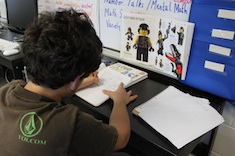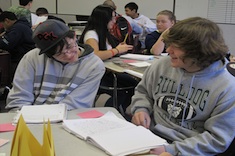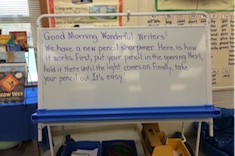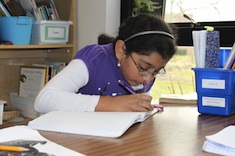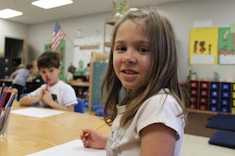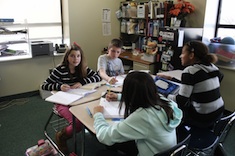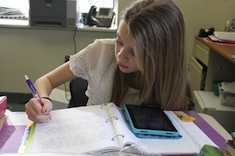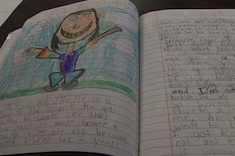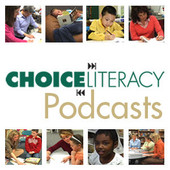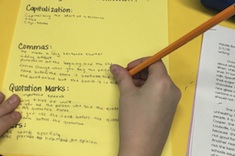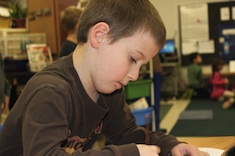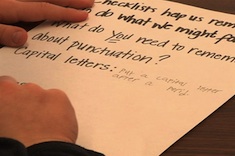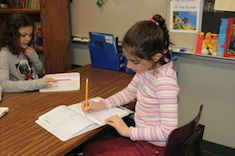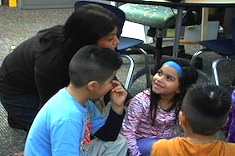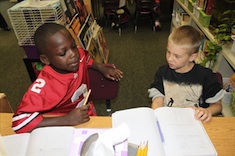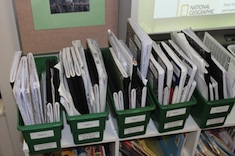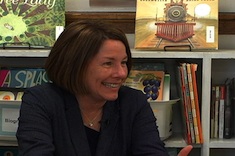Teaching Writing
Everyone who writes for Choice Literacy loves teaching writing, because we all write ourselves. We know it is "hard fun," as Donald Murray famously said—exasperating and exhilarating at the same time. The writing workshops you will read about here and see in our videos are busy, noisy, vibrant places. And most days, we wouldn't want to be anywhere else than in the midst of 'em! Here is where you'll find our latest discoveries, insights, and occasional boneheaded mistakes in teaching writing.
Latest Content
Mentors for Process and Habits
Ruth Ayres shares some of her favorite mentors and mentor texts for developing good writing processes and habits.
From Mentor Texts to Mentors in First Grade
Katie DiCesare uses technology in her first-grade classroom so that students can see the lives of the authors who create the texts they love.
Beginnings, Middles, and Endings: The Power of Baseline Assessments
Carly Ullmer shares how much her seventh-grade students learn from examining their own growth as writers with baseline, midpoint, and final assessments throughout the year.
Getting to Know Writers: Using Quotes
Dana Murphy concludes her series on getting to know writers with an activity on responding to quotes. This activity is a great baseline for gauging attitudes and previous experiences early in the year.
Laying the Foundation for Genre Writing
Shari Frost helps a teacher dealing with dreadful how-to drafts from her students by sharing quality mentor texts.
A Joyful Mess
Ruth Ayres writes about the messiness of analyzing needs, celebrating achievements, and thinking about what’s next with writers in workshops.
Getting to Know Writers: The Writing Process Survey
Dana Murphy continues her series on getting to know writers early in the year. In this installment, she explains how to use a simple six-question survey to help teachers and students explore differences in writing routines and habits.
Getting to Know Writers: Introduction
Dana Murphy writes about the litmus tests we give writing teachers to analyze whether or not they are teaching the "right" way, when we might better serve students by focusing on the six truths of writing.
Last Chance Workshop
Christy Rush-Levine breaks her routine of responding to student writing, and instead calls on students to guide and support peers. She shares some surprising results.
Conferring with Ben: Brainstorming Writing Topics and Genres
Katherine Sokolowski helps fifth grader Ben brainstorm ideas for writing, and in the process encourages him to try a new genre.
“Reinventing Language Every Time You Write” with Ralph Fletcher (PODCAST)
Ralph Fletcher recognizes that many teachers love language and explains how to bring that love of words to young writers.
Writing Models with Kelly Gallagher (PODCAST)
In this podcast, Kelly Gallagher reminds us of the power of the person right next to writers when they are learning the craft.
Tweeting a Favorite Author
Katherine Sokolowski helps one of her fifth-grade students compose a tweet to a favorite author.
Writing for Reflection at the End of the Year
Katherine Sokolowski reflects on ways to extend the learning from an end-of-year activity all the way to the fall.
An Individualized Conventions Checklist
Melanie Meehan finds that a flexible conventions checklist that students develop according to their own needs is the best way to ensure conventions are taught in the context of authentic student work.
Alternatives to Daily Editing as a “Bell-Ringer” Activity
The “daily edit” is a common routine in many classrooms. Shari Frost explains why this may not be an effective way to teach conventions, and offers some alternatives.
Developing Individualized Convention Checklists with Students
Melanie Meehan works with third graders to develop personalized conventions checklists.
The Beauty of Imitation
Jennifer Schwanke explains how concerns about plagiarism can get in the way of recognizing the value of mimicking the styles of other writers to find our own.
Supporting Talk Around Writer’s Craft
Tara Barnett and Kate Mills help young writers move away from seeing editing as “adding more details,” and toward developing more specific language for the revision process.
Strategies for Elaboration in Opinion Writing
Melanie Meehan works with fifth graders who are struggling to elaborate on themes in their opinion writing.
Modeling Nonfiction Writing for English Language Learners: Part 3
Stella Villaba models nonfiction writing for her first- and second-grade English language learners, and in the process integrates vocabulary instruction into her lesson. This is the final video in a three-part series.
Modeling Nonfiction Writing for English Language Learners
Stella Villalba models nonfiction writing for her first- and second-grade English language learners, and in the process integrates vocabulary instruction into her lesson. This is the first video in a three-part series.
From Compliments to Challenges: The Conferring Card
Melanie Meehan uses a conferring card in her writing conference with Cara to ensure she has a record of the strengths and revision possibilities they discussed.
Setting the Stage for Meaningful Peer Feedback
Tara Barnett and Kate Mills develop a scaffold with an index card to help student partners move from agreeable talk to suggestions for revising writing.
Slow Down
Gretchen Schroeder has three strategies for slowing down with her high school students and savoring literacy learning.
Planning and the Tuesday Effect
Mary Lee Hahn realizes how much a workshop approach has changed her planning process and comfort level with the unexpected.
Getting Creative with Writing Celebrations
A celebration is the pause that refreshes between writing units for many teachers. Melanie Meehan shares suggestions for creative celebrations.
Wonder and React
How do you scaffold students for independent work? Melanie Meehan finds Wonder and React is a great strategy to use with fifth graders during an information writing unit.
Maintaining Momentum As a Writer
Jennifer Richard Jacobson chats with a group of fifth graders about how to generate ideas for writing independently each day.
Browse Content By
Type
Category
- Assessment Tools
- Big Fresh Archives
- Booklists
- Choice Numeracy
- Classroom Design
- Common Core
- Community Building
- Conferring
- Content Literacy
- Digital Literacy
- English Language Learners
- Equity
- Family Relations
- Free Samples
- Guiding Groups
- Leadership
- Literacy Coaches
- Mentor Texts
- Minilessons
- New Teacher Mentors
- Podcasts
- Poetry
- Quote Collections
- Reading Strategies
- Self Care
- Struggling and Striving Learners
- Talking and Listening
- Teacher Study Groups
- Teaching Reading
- Teaching Writing
- Word Study and Vocabulary
Author
- Melissa Quimby
- Nawal Qarooni
- Gwen Blumberg
- Julie Cox
- The Lead Learners
- Hannah Tills
- Josie Stewart
- Ruth Metcalfe
- Mallory Messenger
- Becca Burk
- Jodie Bailey
- Vivian Chen
- Mary Brower
- Tiffany Abbott Fuller
- Stephanie Affinito
- Ruth Ayres
- Leigh Anne Eck
- Heather Fisher
- Shari Frost
- Julie Johnson
- Suzy Kaback
- Gigi McAllister
- Shirl McPhillips
- Melanie Meehan
- Cathy Mere
- Debbie Miller
- Tara Barnett and Kate Mills
- Tammy Mulligan
- Dana Murphy
- Bitsy Parks
- David Pittman
- Brenda Power
- Heather Rader
- Matt Renwick
- Mandy Robek
- Christy Rush-Levine
- Gretchen Schroeder
- Jen Schwanke
- Brian Sepe
- Katherine Sokolowski
- Stella Villalba
- Jennifer Vincent
Grade Level
Choice Literacy Membership
Articles
Get full access to all Choice Literacy article content
Videos
Get full access to all Choice Literacy video content
Courses
Access Choice Literacy course curriculum and training

